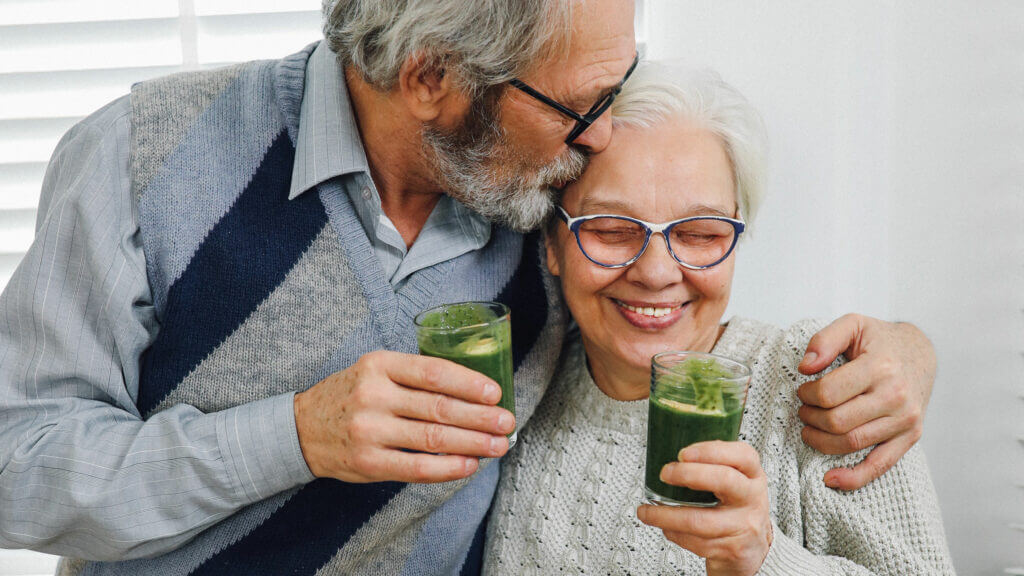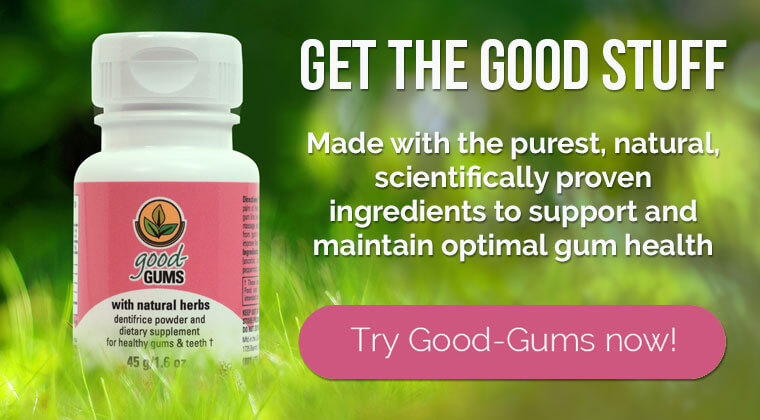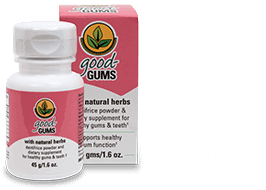PROMOTING GUM HEALING AND MAINTAINING HEALTHY GUMS
Part 3 of our series of Reference Articles explaining the proven science behind the Good-Gums, how it works so well, and why. Read article 1 – Read article 2.
Ingredients in the Good-Gums formula have beneficial effects for oral health that have been established and confirmed by a number of clinical trials, studies and peer-reviewed scientific articles. The formula is specifically designed so that all our ingredients work in concert for maximum effectiveness in tackling a range of gum issues.
The Good-Gums formula contains ingredients shown to actively support the growth of new healthy gum cells, but in addition also contains ingredients shown to soothe sore or inflamed tissue, which can be important when addressing gums that need help and support. These soothing ingredients have been used since ancient times (in biblical times and even before), and have long been esteemed by both practitioners and beneficiaries of traditional medicines. Modern research has recently confirmed their tissue-soothing properties.
This article cites and reviews published articles and clinical trials on the tissue-soothing properties of these ingredients of Good-Gums:
- Myrrh
- Peppermint
- Cinnamon
- and high-mineral sea salt
Citations for the sources of the information are indicated by parentheses in the text.

MYRRH
Myrrh is famous in the Western world as being one of the precious gifts of the Magi, and for good reason considering its analgesic, mildly anesthetic and anti-inflammatory properties. In nature, myrrh comes as a resinous sap from a small tree, and has been used in that form (resin or powdered dry resin) for millennia. This is the form in which it is used in Good-Gums. Modern processes can extract the essential oil, which concentrates the strength to be approximately 100 times that of the resin; however we at Good-Gums think that this is too intense for delicate soft oral tissues, and so we prefer the traditional form, whose effectiveness has been established by many scholarly articles.
An article in the Journal of Ethnopharmacology documents the anti-inflammatory and anti-pain characteristics of myrrh in various lands throughout the ancient world: in what’s known today as the Middle East (the Holy Land), in China and in India. Modern researchers tested both isolated metabolites and crude unprocessed extract, and found that “pharmacological results have validated the use of this genus in the traditional medicines.’ (1)
The introductory section of a clinical trial’s report noted that myrrh had been recommended by Hippocrates for sores, and that the ancient Romans used it for treating mouth infections. The actual clinical trial established that myrrh had a easily-measurable analgesic effect, similar in character (even if not with similar strength and also without the addictive character) to that of morphine. (2)
A study that reviewed over 70 peer-reviewed papers on the medicinal importance and safety of myrrh found that the genus Commiphora (myrrh) is used successfully as a natural drug to treat pain, inflammatory conditions and periodontal diseases, among other uses. It noted that in recent years myrrh was becoming recognized as possessing significant anesthetic properties. (3)
An article on myrrh by RxList (a listing of medicines that is maintained by WebMD) notes that “Myrrh is applied directly to the mouth for soreness and swelling, inflamed gums (gingivitis), loose teeth, canker sores, bad breath, and chapped lips.” It also noted that it can help decrease swelling (inflammation). (4) Other studies have confirmed the effectiveness of myrrh for its anesthetic activity (5), (6), (7), (8), (9) and particularly for use on gums. (10), (11)
PEPPERMINT
Peppermint is considered in the Western Hemisphere as the oldest medicine in history. Dried leaves found in Egyptian pyramids were dated to approximately 1,000 BC. (12) Ancient Greek and Roman (e.g., Pliny the Elder’s) texts cited peppermint for its medicinal properties. (13) In the 1700’s Peppermint started coming under the scrutiny of the newly emerging scientific community, and cultivation of peppermint as a medicinal plant became a serious undertaking in Britain in the 1800’s. (14)
Modern studies demonstrate peppermint’s ability to relieve pain. A review of the health benefits of peppermint reported analgesic effects from in vivo studies in humans. (15) The menthol in peppermint (more prevalent there than in any other mint species) was shown to have “analgesic (pain killer), local anesthetic and counter-irritant properties.” (16)
CINNAMON
A botanical with a long history of use in traditional medicine. It is part of the bark of an evergreen tree that originated in southern China, so its oldest use was in Asia. (17) Modern studies confirm its effectiveness, including a study that showed it to be one of the most potent anti-inflammatory herbs among 115 foods tested. (18) “Modern studies have confirmed that cinnamon benefits human health in a variety of ways, including … anti-inflammatory and analgesic effects.” (19) A lab-based study found that cinnamon has strong anti-inflammatory properties. (20)
FRENCH GREY SEA SALT
This naturally occurring mineral has a strikingly similar mineral balance to the fluids of the human body. Particularly valuable is the trace mineral profile of sea salt, contrasting with ordinary mined table salt, which is often relatively depleted. French grey sea salt has a trace mineral content even greater than of other sea salts, because it is harvested in ponds lined with the high-mineral clay of the shores of the Celtic Sea (21), instead of being harvested in conventional cement-lined ponds. The Celtic Sea adjacent to the French coast of Brittany is a part of the Atlantic Ocean that is particularly clean of pollutants. (22), (23)
“In 1904, a French biologist/physiologist, René Quinton, proved that human blood composition, or to be more precise, blood plasma is very close to the composition of sea water. It contains every mineral and trace mineral known in organic form and in the proportions needed by tissues of the human body.” (24), (25)
It turns out that seawater has a chemical composition similar to plasma in all mammals. Back in the days when animal experiments were common and even considered normal, Quinton drained blood from dogs, which caused them to breathe with difficulty and to be unable to walk, remaining stretched out without moving. He then replaced the blood with sea water diluted to an isotonic 0.9%, which matches the level of mineral concentration of blood plasma. The level of red And white blood cells immediately started increasing, and continued doing so for the next several days. “The results showed that the organism had become revitalized by the seawater to a level that EXCEEDED that before the blood had been withdrawn. Five years later, Sodium [the dog], so named in memory of the experiment, was still alive and well.” (26)
Returning to human usage, the close compatibility between sea salt water and human blood was borne out by the successful use of sea salt water instead of human blood for transfusions during emergencies, such as in wartime or in surgeries when religious beliefs forbade people from introducing blood into their bodies. (27) This convention, while not common, is still occasionally practiced.
The proven close compatibility of high-mineral sea salt water and human bodily fluids makes for more compatible acceptance by the body of the dissolved high-mineral sea salt. Its inclusion in the Good-Gums formula takes advantage of this marvel.
FINAL OBSERVATIONS
You might find that ingredients highlighted here for their tissue-soothing properties might also be listed in our other articles in this series for their additional anti-microbial properties. That’s because our ingredients are not merely component chemicals that were isolated and extracted from herbs and minerals, but instead are the whole natural herbs and minerals themselves, with all their nuance, as close to their unprocessed natural form as practicable.

We hope you’ve enjoyed learning this information.
Now that you’ve gotten some insight into how effective Good-Gums is in soothing gum tissue, you can start taking control of your own oral health. So whether you want to treat gum disease, restore receding gums or tackle periodontitis, you can rest assured that Good-Gums has the power to support your healing and that it’s backed by good science.
Purchase your first bottle now and get started.

CITATIONS – PEER REVIEWED STUDIES, REPORTS AND ARTICLES ON THE SOOTHING AND HEALING PROPERTIES OF GOOD-GUMS INGREDIENTS
(1) The Genus Commiphora: a Review of Its Traditional Uses, Phytochemistry and Pharmacology; Journal of Ethnopharmacology; 2012 Jul; by Tao Shen, Guo-Hui Li, Xiao-Ning Wang, Hong-Xiang Lou; https://pubmed.ncbi.nlm.nih.gov/22626923/
(2) Analgesic Effects of Myrrh. Nature 1996; by Dolara P, Luceri C, Ghelardini C, et al.; http://www.encognitive.com/node/15074
Note: This study’s clinical trial on myrrh took place more than 20 years before the start of Good-Gums, and although it involved the use of animals, no animal testing has ever been done with Good-Gums.
(3) An update Review on Commiphora Molmol and Related Species; Journal of the Egyptian Society of Parasitology; 2008 Dec; by by Abdulkader M D Tonkal , Tosson A Morsy; https://pubmed.ncbi.nlm.nih.gov/19209761/
(4) Myrrh;RxList; vitamins, herbs, dietary supplements a-z list; myrrh; Reviewed on 6/11/2021; https://www.rxlist.com/myrrh/supplements.htm
(5) Local Anaesthetic, Antibacterial and Antifungal Properties of Sesquiterpenes from Myrrh; Planta Medica; June 2000; by Dolara, Piero & Corte, Barbara & Ghelardini, Carla & Pugliese, Anna & Cerbai, Elisabetta & Menichetti, Stefano & Lo Nostro, Antonella.; https://www.researchgate.net/publication/12454253_Local_Anaesthetic_Antibacterial_and_Antifungal_Properties_of_Sesquiterpenes_from_Myrrh
(6) Effect of Myrrh (Commiphora molmol) on Leukocyte Levels Before and During Healing from Gastric Ulcer or Skin Injury; Journal of Immunotoxicology; 2010 Mar; by Al-Said A Haffor; https://pubmed.ncbi.nlm.nih.gov/19995243/
(7) A Combined Water Extract of Frankincense and Myrrh Alleviates Neuropathic Pain in Mice via Modulation of TRPV1; Neural Plasticity; 2017; by Danyou Hu , Changming Wang , Fengxian Li, Shulan Su, Niuniu Yang, Yan Yang, Chan Zhu, Hao Shi, Lei Yu, Xiao Geng, Leying Gu, Xiaolin Yuan , Zhongli Wang, Guang Yu, Zongxiang Tang; https://pubmed.ncbi.nlm.nih.gov/28740739/
(8) Myrrh: Medical Marvel or Myth of the Magi?; Holistic Nursing Practice; 2007; by Effie Y H Nomicos; https://pubmed.ncbi.nlm.nih.gov/17978635/
(9) Myrrh; Herbs -> myrrh; https://naturalhealthtechniques.com/myrrh/
(10) Medicinal Properties of Myrrh; WRIC Health, Medicinal Plants; 2018;https://wric-health.com/eng/medicinal-plants/medicinal-properties-of-myrrh/
(11) MYRRH; MEDICINAL QUALITIES OF MYRRH; by Rebecca Joy Knottnerus; https://www.herballegacy.com/Knottnerus_Medicinal.html
(12) History of Peppermint; Peppermint Medicinal Use in History; https://www.youngliving.com/en_GB/discover/history-of-essential-oils/History-of-Peppermint
(13) Peppermint History – Exploring the Historical Roots; https://livseasun.com/peppermint-history-exploring-historical-roots/
(14) Ibid.
(15) A review of the bioactivity and potential health benefits of peppermint tea (Mentha piperita L.); Phytotherapy Research; 2006 Aug; by Diane L McKay 1 , Jeffrey B Blumberg; https://pubmed.ncbi.nlm.nih.gov/16767798/
(16) Peppermint Herb Nutrition Facts; https://www.nutrition-and-you.com/peppermint.html
(17) 8 Cinnamon Benefits: Dosage & Safety; by Daniel Powers, MS; published on: June 9, 2022; https://botanicalinstitute.org/cinnamon/
(18) Anti-inflammatory Activity of Cinnamon (C. zeylanicum and C. cassia) Extracts – identification of E-cinnamaldehyde and o-methoxy cinnamaldehyde as the Most Potent Bioactive Compounds; Food & Function; 2015 March; by Dhanushka Gunawardena 1 , Niloo Karunaweera, Samiuela Lee, Frank van Der Kooy, David G Harman, Ritesh Raju, Louise Bennett, Erika Gyengesi, Nikolaus J Sucher, Gerald Münch; https://pubmed.ncbi.nlm.nih.gov/25629927/
(19) 8 Cinnamon Benefits: Dosage & Safety; by Daniel Powers, MS; published on: June 9, 2022; https://botanicalinstitute.org/cinnamon/
(20) Ibid.
(21) French sea salt; https://www.loveseasalt.com/what-is-french-sea-salt/
(22) Toxic and Carcinogenic Plastics are Found in Fifteen Sea Salt Brands from Different Countries; The Daiily Health Post; https://dailyhealthpost.com/microplastics-in-the-ocean/2/
(23) The Presence of Microplastics in Commercial Salts from Different Countries; Nature; 2017 April; by Ali Karami, Abolfazl Golieskardi, Cheng Keong Choo, Vincent Larat, Tamara S. Galloway & Babak Salamatinia; https://www.nature.com/articles/srep46173#conclusions
(24) Human Blood Plasma and Seawater; https://whatisanormalbloodsugarlevel.com/blood-plasma-and-seawater/
(25) Seawater As A Safe Blood Plasma Substitute; https://whatisanormalbloodsugarlevel.com/seawater-a-safe-blood-plasma-substitute/
(26) Quinton’s Ocean Plasma Experiments with Dogs; Dancing With Water; 2011; byMJ Pangman and Melanie Evans; https://www.dancingwithwater.com/quintons-ocean-plasma-experiments-with-dogs/
(27) Blood Transfusions or Seawater; Awake; 1973; https://wol.jw.org/en/wol/d/r1/lp-e/101973405
Read the other two articles in this series here:
Good Gum Science #1 – Ingredients that support the growth of healthy new gum cells
Good Gum Science #2 – Anti-microbial ingredients and their effects
Or visit our Reference Articles Introduction Page.


